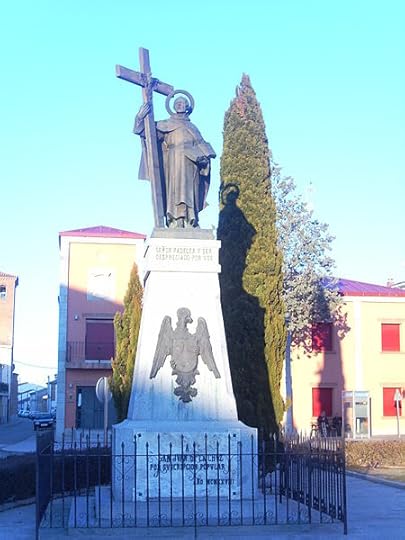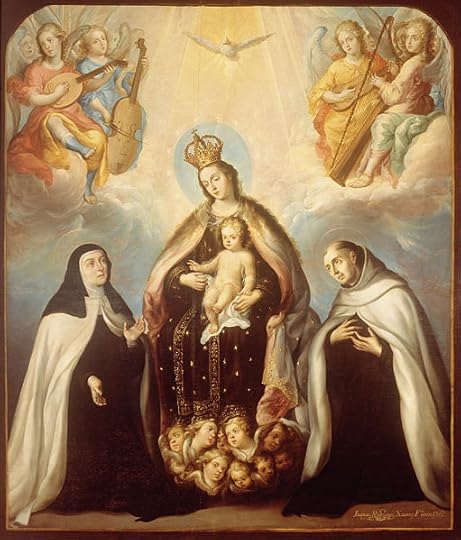Connie Rossini's Blog, page 7
December 15, 2015
The Spiritual Canticle of St. John of the Cross

Wedded by Frederic Lord Leighton (Wikimedia Commons). The soul is the Bride of Christ.
Most people who read St. John of the Cross (whose feast day was yesterday), read The Ascent of Mount Carmel or Dark Night of the Soul. This is unfortunate. Fr. Gabriel of St. Mary Magdalen advises:
One should not make one’s first acquaintance with the Saint through The Ascent of Mt Carmel; the first book one ought to take in hand is the Spiritual Canticle… From its very first pages [it] brings to one’s notice the magnificent goal to which the Saint intends to lead the soul.” (Union with God, ch. 2).
In The Spiritual Canticle, St. John shows us the intimacy with God that we can attain if we persevere. It is a love story between God and the soul. We cannot accept John’s doctrine of detachment presented in his other works unless we understand that detachment is a means to union with God. The soul that is totally in love with God will gladly give up everything for union with Him.
Detachment without love as its motive is more akin to Buddhism than Christianity. If we lose sight of the goal, we will never persevere.
The Spiritual Canticle was written as a poem, an expression of John’s burning love for God. When the Carmelite nuns of Breas read it, they urged John to explain what it meant. He knew that poetry came closer to expressing the deep things of God than prose. So he did not try to explain every word of his poem, but the general sense of it.
Following is the (public domain) translation by Benedict Zimmerman, OCD. I encourage you to read and meditate on these stanzas over the next few weeks as part of your prayer for a deeper union with Christ this Christmas. In January I plan to address the major themes covered in this work.
God lead your meditations!
Connie Rossini
SONG OF THE SOUL AND THE BRIDEGROOMITHE BRIDEOther posts you may likeWhere have You hidden Yourself,
And abandoned me in my groaning, O my Beloved?
You have fled like the hart,
Having wounded me.
I ran after You, crying; but You were gone.
IIO shepherds, you who go
Through the sheepcots up the hill,
If you shall see Him
Whom I love the most,
Tell Him I languish, suffer, and die.
IIIIn search of my Love
I will go over mountains and strands;
I will gather no flowers,
I will fear no wild beasts;
And pass by the mighty and the frontiers.
IVO groves and thickets
Planted by the hand of the Beloved;
O verdant meads
Enameled with flowers,
Tell me, has He passed by you?
VANSWER OF THE CREATURESA thousand graces diffusing
He passed through the groves in haste,
And merely regarding them
As He passed
Clothed them with His beauty.
VITHE BRIDEOh! who can heal me?
Give me at once Yourself,
Send me no more
A messenger
Who cannot tell me what I wish.
VIIAll they who serve are telling me
Of Your unnumbered graces;
And all wound me more and more,
And something leaves me dying,
I know not what, of which they are darkly speaking.
VIIIBut how you persevere, O life,
Not living where you live;
The arrows bring death
Which you receive
From your conceptions of the Beloved.
IXWhy, after wounding
This heart, have You not healed it?
And why, after stealing it,
Have You thus abandoned it,
And not carried away the stolen prey?
XQuench my troubles,
For no one else can soothe them;
And let my eyes behold You,
For You are their light,
And I will keep them for You alone.
XIReveal Your presence,
And let the vision and Your beauty kill me,
Behold the malady
Of love is incurable
Except in Your presence and before Your face.
XIIO crystal well!
Oh that on Your silvered surface
You would mirror forth at once
Those eyes desired
Which are outlined in my heart!
XIIITurn them away, O my Beloved!
I am on the wing:
THE BRIDEGROOMReturn, My Dove!
The wounded hart
Looms on the hill
In the air of your flight and is refreshed.
XIVMy Beloved is the mountains,
The solitary wooded valleys,
The strange islands,
The roaring torrents,
The whisper of the amorous gales;
XVThe tranquil night
At the approaches of the dawn,
The silent music,
The murmuring solitude,
The supper which revives, and enkindles love.
XVICatch us the foxes,
For our vineyard has flourished;
While of roses
We make a nosegay,
And let no one appear on the hill.
XVIIO killing north wind, cease!
Come, south wind, that awakens love!
Blow through my garden,
And let its odors flow,
And the Beloved shall feed among the flowers.
XVIIIO nymphs of Judea!
While amid the flowers and the rose-trees
The amber sends forth its perfume,
Tarry in the suburbs,
And touch not our thresholds.
XIXHide yourself, O my Beloved!
Turn Your face to the mountains,
Do not speak,
But regard the companions
Of her who is traveling amidst strange islands.
XXTHE BRIDEGROOMLight-winged birds,
Lions, fawns, bounding does,
Mountains, valleys, strands,
Waters, winds, heat,
And the terrors that keep watch by night;
XXIBy the soft lyres
And the siren strains, I adjure you,
Let your fury cease,
And touch not the wall,
That the bride may sleep in greater security.
XXIIThe bride has entered
The pleasant and desirable garden,
And there reposes to her heart’s content;
Her neck reclining
On the sweet arms of the Beloved.
XXIIIBeneath the apple-tree
There were you betrothed;
There I gave you My hand,
And you were redeemed
Where your mother was corrupted.
XXIVTHE BRIDEOur bed is of flowers
By dens of lions encompassed,
Hung with purple,
Made in peace,
And crowned with a thousand shields of gold.
XXVIn Your footsteps
The young ones run Your way;
At the touch of the fire
And by the spiced wine,
The divine balsam flows.
XXVIIn the inner cellar
Of my Beloved have I drunk; and when I went forth
Over all the plain
I knew nothing,
And lost the flock I followed before.
XXVIIThere He gave me His breasts,
There He taught me the science full of sweetness.
And there I gave to Him
Myself without reserve;
There I promised to be His bride.
XXVIIIMy soul is occupied,
And all my substance in His service;
Now I guard no flock,
Nor have I any other employment:
My sole occupation is love.
XXIXIf, then, on the common land
I am no longer seen or found,
You will say that I am lost;
That, being enamored,
I lost myself; and yet was found.
XXXOf emeralds, and of flowers
In the early morning gathered,
We will make the garlands,
Flowering in Your love,
And bound together with one hair of my head.
XXXIBy that one hair
You have observed fluttering on my neck,
And on my neck regarded,
You were captivated;
And wounded by one of my eyes.
XXXIIWhen You regarded me,
Your eyes imprinted in me Your grace:
For this You loved me again,
And thereby my eyes merited
To adore what in You they saw
XXXIIIDespise me not,
For if I was swarthy once
You can regard me now;
Since You have regarded me,
Grace and beauty have You given me.
XXXIVTHE BRIDEGROOMThe little white dove
Has returned to the ark with the bough;
And now the turtle-dove
Its desired mate
On the green banks has found.
XXXVIn solitude she lived,
And in solitude built her nest;
And in solitude, alone
Has the Beloved guided her,
In solitude also wounded with love.
XXXVITHE BRIDELet us rejoice, O my Beloved!
Let us go forth to see ourselves in Your beauty,
To the mountain and the hill,
Where the pure water flows:
Let us enter into the heart of the thicket.
XXXVIIWe shall go at once
To the deep caverns of the rock
Which are all secret,
There we shall enter in
And taste of the new wine of the pomegranate.
XXXVIIIThere you will show me
That which my soul desired;
And there You will give at once,
O You, my life!
That which You gave me the other day.
XXXIXThe breathing of the air,
The song of the sweet nightingale,
The grove and its beauty
In the serene night,
With the flame that consumes, and gives no pains.
XLNone saw it;
Neither did Aminadab appear
The siege was intermitted,
And the cavalry dismounted
At the sight of the waters.
December 9, 2015
10 ways to celebrate the Year of Mercy

Jesus, I trust in you!
Yesterday the Jubilee Year of Mercy began in the Church. How can you fully participate in the graces of this holy year? Here are ten ideas for you and your family.
1. Go to confession more often.How often do you participate in the Sacrament of Reconciliation? Can you make it more often? Once a month is a good starting place for people who are trying to grow in holiness.
2. Forgive those who have hurt you.Is anyone estranged from you because of a past conflict? Reach out to them in love this year. Tell them you forgive them and you want to start the relationship over.
3. Cancel debts.In the Lord’s Prayer we say, by one translation, “Forgive us our debts, as we forgive our debtors.” Do you have literal debts owed you that you can cancel? Maybe a friend borrowed money and is afraid to tell you he can’t pay it back. Maybe a son or daughter needed a temporary loan. Maybe a renter is behind on payments because he lost his job. Astonish them by telling them they don’t have to pay part or all of what they owe. Tell them you are celebrating the Jubilee Year of Mercy.
4. Read the diary of St. Faustina.St. Faustina Kowalska wrote Divine Mercy in My Soul to herald the mercy of God. It’s several hundred pages long and well worth the time it takes to read. Set aside fifteen minutes a day this year to learn how much God loves sinners.
5. Pray the Divine Mercy Chaplet.December 2, 2015
John of the Cross and the contemplative life

St. Jerome by Georges de La Tour (Wikimedia Commons). Prayer and mortification are the keys to preparing for the gift of infused contemplation.
What is the contemplative life? What does it entail? What is its purpose? Let’s start our study of St. John of the Cross’s spirituality with these questions.
November 25, 2015
Becoming a contemplative family

Early 20th Century Bible card from the Providence Lithograph Company. Offering your family’s first fruits to God, Deut. 26:1-11. (Wikimedia Commons)
Last month I wrote a call for contemplative families. Now it’s time to begin discussing what that means. Here are a number of my past posts on praying with children, in case you have missed them:
November 18, 2015
Who was St. John of the Cross?

Monument to St. John of the Cross in Fontiveros, Spain. (Photo by Dahis, Wikimedia Commons.)
Let’s start our study of St. John of the Cross with an examination of his life and the context of his work.
Juan de Yepes was born in Fontiveros, Spain in 1542. He was the youngest of three brothers. His father died of a long illness when John was only two. (Did you notice the similarities with St. Therese?) The family then moved to Medina del Campo, where John grew up in poverty.
An influential person recognized John’s gifts and helped him enter a Jesuit school, where he studied both the classics and theology. After graduating, John rejected offers to be a hospital chaplain and to enter the Jesuits. Instead, he became a Carmelite friar. He then studied philosophy and theology in Salamanca.
Meeting St. TeresaBut John was dissatisfied. He pondered joining the Carthusians. In 1567 St. Teresa of Avila came to Medina to found the second monastery of the reform. Looking to add friars to her movement, she sought out John. The following year he joined her on a journey to found a new monastery in Valladolid.
Teresa’s ideal was to have smaller communities, dedicated to prayer, silence, solitude, and a simple life. She had already written The Book of Her Life and The Way of Perfection. She was 52. John was only 25.
After a novitiate under Teresa, John and some other men founded a monastery in Duruelo. Soon Teresa called him to be the confessor for the nuns in Avila, where she had become prioress. It was 1572.
Later that year, while under John’s direction, Teresa was granted the Spiritual Marriage, the height of the Christian life on earth. At the same time, he acted as director to many lay people in Avila.
Imprisonment and EscapeThe reform of the Carmelites was mixed up in Spanish politics and attacked by other religious, even within the order. In 1576, the Carmelites who were not part of the reform (called Carmelites of the [Ancient] Observance), arrested John. The papal nuncio won his release. But when the nuncio died a year later, his enemies saw their chance. They kidnapped John and imprisoned him in the Carmelite monastery in Toledo.
Later, John escaped in the middle of the night. The experience inspired him to write these words:
One dark night,
fired with love’s urgent longings
–ah, the sheer grace!–
I went out unseen,
my house being now all stilled.
And the spiritual classic The Dark Night (of the Soul) was born.
During his imprisonment he had been composing part of The Spiritual Canticle and other works.
Later yearsJohn hid for a time with Teresa’s nuns in Toledo, then at a hospital. After more intrigue, John eventually settled for a short time at the Beas monastery. He taught for a time at a Carmelite college. In 1582 he became prior of the monastery in Granada, and vicar provincial of Andalusia in 1585. He founded seven monasteries before becoming the prior in Segovia.
The last work he completed was The Living Flame of Love. After that he tried to dedicate his life to prayer, but turmoil in the order and the pleas of lay people for spiritual direction kept him busy. The new general of the order planned to send him on a mission to Mexico to get rid of him. But soon John fell ill with a sickness that would end in his death. He died in Ubeda, just after midnight on December 14, 1591.
My next post in this series will begin looking at his spirituality.
By the way, in case you missed it, I replied to my critics about Centering Prayer in
November 11, 2015
Time alone with God
November 4, 2015
The writings of St. John of the Cross

Our Lady of Mt. Carmel with Saint Theresa and Saint John of the Cross by Juarez (Wikimedia Commons).
Now that we have finished our series on Interior Castle, I’d like to begin looking at the teaching of St. John of the Cross. This will be an occasional series, planned to be posted over the next year. Sometimes I will post on other subjects that inspire me.
Let’s begin with an introduction to St. John’s works and a few good books written about them.
John is most famous for his poems The Dark Night (of the Soul) and The Ascent of Mt. Carmel. But he wrote two other major works also, The Spiritual Canticle and The Living Flame of Love. He wrote many one-sentence maxims that are grouped differently depending on which editor or translator you read. I will be using the standard English version of his works, The Collected Works if St. John of the Cross translated by Kieran Kavanaugh and Otilio Rodriguez. Kavanaugh and Rodriguez group all John’s maxims as The Sayings of Light and Love. There are also short works of counsels and letters. And let’s not forget his shorter poems.
A difficult spirituality?We know that Teresa of Avila’s work are sometimes misconstrued to promote unorthodox spiritualities such as Centering Prayer. This is true of John of the Cross’s works as well. John’s writing is more obscure than Teresa’s. Some find it frightening.
Fr. Jordan Aumann, O.P. Writes:
One cannot discuss Teresa of Avila without thinking of her great collaborator, St. John of the Cross. They are so closely related in their life and work and doctrine that they are like two pillars on which is constructed the Carmelite school of spirituality. St. John of the Cross (1542-1591) is not as widely known and read as he deserves, and there are several reasons for this: he wrote primarily for souls that are already advanced on the path of perfection; his teaching on detachment and purgation is too demanding for some Christians; his language is often too subtle and mystical to suit the taste of modern readers. Yet, his writings and those of St. Teresa compliment each other so perfectly that one of the best ways to understand either one is to study the works of the other.” (
October 28, 2015
Saints Louis and Zelie Martin: greatness in service
October 20, 2015
The seventh mansions

Church window in the Convent of St. Teresa, Caballeros, Spain. Photo by Håkan Svensson (Xauxa), Wikimedia Commons.
At last, we have arrived at the seventh mansions of the Interior Castle! Well, in our blog posts anyway. In case you were wondering, I have not arrived there yet in my own soul. Since it is impossible to understand many of the things Teresa writes about here without having experienced them, I’m going to sum up her four chapters briefly.
The seventh mansions are the mansions of the spiritual marriage. But even here, there is growth in the soul. And the union, although it becomes the closest union possible while on earth, still falls short of the Beatific Vision of Heaven.
The same is true of knowledge. Teresa says that the soul sees and understands things in the seventh mansion that it could not before. She sees that spirit and soul, for example, are slightly different things. But she does not fully understand the distinction. Full knowledge waits for Heaven, where, as St. Paul tells us:
Then I shall know fully, even as I am fully known. (1 Corinthians 13:12).
The soul in the seventh mansions has an intellectual vision of the Holy Trinity. She does not see the Trinity with her imagination, but she knows with certainty and really experiences God as three in one. She also experiences a vision of Christ. Teresa mentions both an intellectual vision and an imaginary vision. I do not know whether she is referring to two separate visions or speaking about different ways in which different soul experience this vision. For Teresa, she saw the risen and glorified Lord after receiving Communion.
The spiritual marriage takes place in the innermost room of the soul, the dwelling place of God Himself. It is like Heaven in the midst of the soul. All throughout the soul’s daily occupation, she continues to experience this union, although it is not always of the same intensity. She is aware of it at times as we can be aware of the presence of other people in a dark room. They were there when the lights were on. When the lights go out, we know they are present still, even though we can’t see them.
Teresa also says it is as if the soul is both Mary and Martha at the same time. Some part of the soul is always in a peaceful union, and the rest of the soul, which works and suffers, is in a sense envious of this inner calm.
Dryness in prayer is almost completely gone. However, sometimes the Lord seems to leave for up to a day at a time. This happens rarely, to remind the soul that union is completely outside her power.
In the earlier mansions, the soul has desired death so as to be united with Christ. Now she desires to live, because only by living can she suffer so as to do good for other souls. She would be willing to stay on earth forever if it would help someone else to love the Lord. Yet this separation from Him is itself the greatest suffering she can offer for others’ sakes.
The soul easily loves her enemies. She careful avoids sin and imperfections—although she may still commit now and then what are objectively venial sins. She does this inadvertently.
And then there is the union itself. Teresa can only describe this profound union by pointing to the words of Christ:
that they may all be one; even as thou, Father, art in me, and I in thee, that they also may be in us (Jn 17:21).
She also uses the analogy of light coming in from two different windows and meeting and becoming one. You cannot separate out any longer which light came from which window. The two are one. Or it is like a stream that flows into a great river. It is no longer separate from the river. Or rain that falls into a lake that becomes one with the lake.
In all these analogies it’s important to recognize she is not saying that the soul and God are the same thing. But “the two become one.” Separation through sin is still possible, and the soul is more careful than ever, more fearful (with a filial fear) than ever of falling.
These then are some of the many ways in which St. Teresa describes life in the seventh mansions, the height of the spiritual life on earth. I pray that all of us may attain to such a union!






